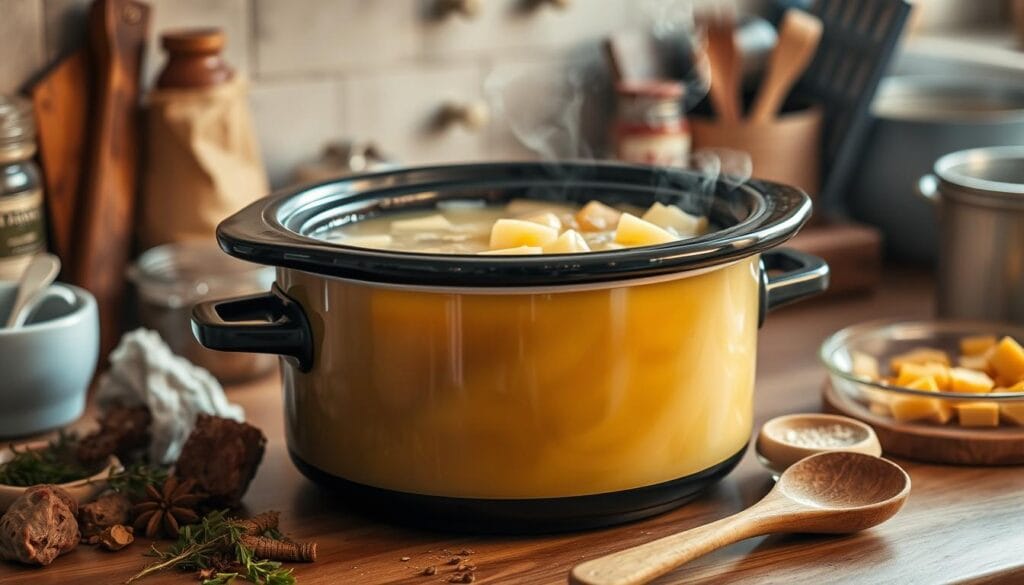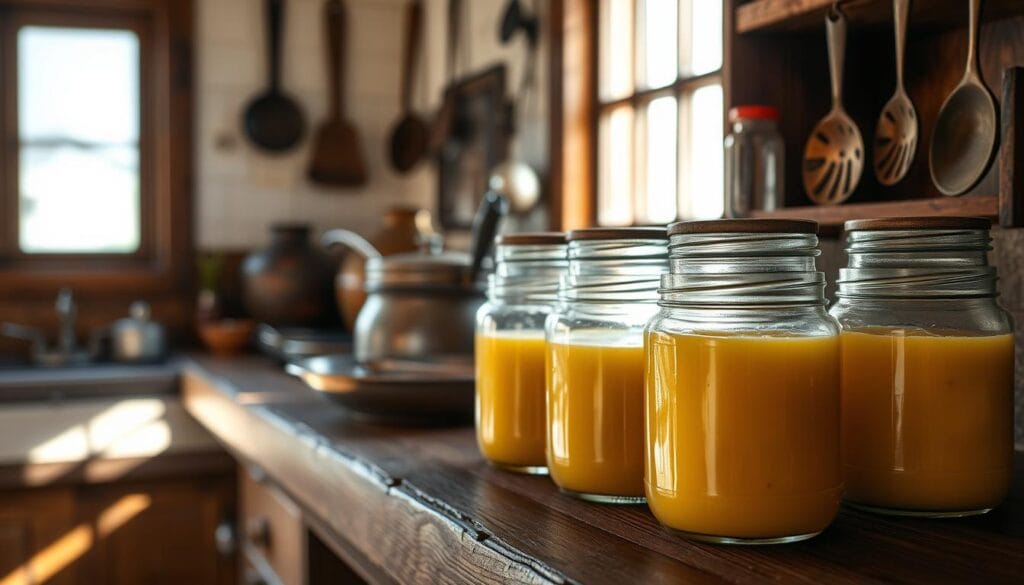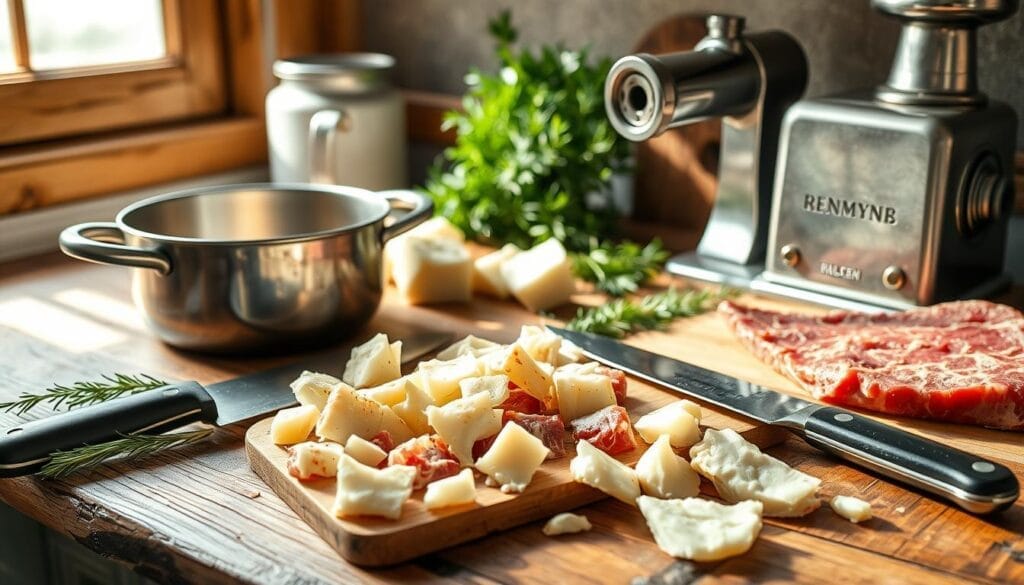Making Beef Tallow: Easy Step-by-Step Guide for Beginners
As a young cook, I remember my first time making beef tallow at home. The smell of it filled my kitchen, reminding me of my grandmother’s kitchen. There, homemade French fries sizzling in beef fat were a treat.
Starting with beef tallow is exciting. It’s great for frying, sautéing, and roasting because it has a high smoke point. It also has vitamins A, D, E, and K, and conjugated linoleic acid (CLA), which are good for you.

Table of Contents
Key Takeaways
- Beef tallow is a versatile cooking fat with a high smoke point, perfect for frying, baking, and roasting.
- Rendering beef tallow at home is a straightforward process that can be done in the oven or slow cooker.
- Properly stored tallow can last for months in the fridge or years in the freezer.
- Beef tallow is rich in essential vitamins and contains the beneficial compound CLA.
- Grass-fed beef fat is recommended for the best nutritional profile.
Understanding Beef Tallow: A Traditional Cooking Fat
Beef tallow has been a staple in cooking for centuries. It’s known for its rich flavor, high smoke point, and unique nutritional benefits. Its versatility and long history make it a great addition to any kitchen.
What Makes Beef Tallow Special
Grass-fed beef tallow is special because it has more omega-3 fatty acids and CLA. These can help fight inflammation and improve heart health. It also has more vitamins A and E than grain-fed tallow, offering better antioxidant protection.
Historical Significance in Cooking
Tallow has a rich history in cooking. McDonald’s used it to fry their famous French fries until the 1990s. Now, it’s known for its high smoke point and strong flavor, making it perfect for searing, frying, and baking.
Nutritional Benefits of Beef Tallow
Beef tallow is packed with saturated fats, vitamins A, D, E, and K, and essential fatty acids. These nutrients support the immune system and improve skin health. It also helps with weight management, making it a great part of a balanced diet.
“Incorporating grass-fed or 100% grass-fed beef tallow into home cooking can enrich a variety of recipes, adding depth and flavor to dishes like Mexican carnitas, Middle Eastern kibbeh, Italian polenta, and French confit.”
Essential Equipment and Tools for Rendering
Rendering your own beef tallow at home is rewarding. But you need the right equipment for a smooth process. Whether using the oven, slow cooker, or stovetop, the right tools are key.
The essential items for making beef tallow include:
- A heavy-duty, oven-safe pot or slow cooker. This will be your primary rendering vessel, so choose one with a thick, sturdy bottom to prevent scorching.
- A fine-mesh strainer or cheesecloth. This is crucial for separating the liquid rendered beef fat from any solid bits or impurities.
- Mason jars or other airtight containers. These are ideal for storing your freshly rendered tallow once it has cooled and solidified.
- A funnel. This makes pouring the tallow into your storage containers much easier and neater.
- Optional: A hand blender. This can speed up the rendering process by helping to break down the fat more efficiently.
If you plan to render tallow in the oven, you’ll also want an 8×8 inch baking dish or similar oven-safe pan to contain the fat as it renders.
“Properly rendered beef tallow, when stored in a cool place, can keep for a few months; stored in the fridge, it can last longer, and it can be frozen for several months.”
With these essential tools, you’ll be ready to start your beef tallow journey. Enjoy the many benefits of homemade rendered beef fat.
Selecting the Right Beef Fat for Tallow
Choosing the right fat is key when making homemade beef tallow. Look for fresh or frozen beef fat, like suet, brisket trimmings, or beef belly. It should smell clean and have a mild beefy taste. Stay away from fat with white spots, as they might mean mold.
Different Types of Beef Fat
- Suet: This hard, dense fat comes from around the kidneys and loins of cattle. Suet tallow is loved for its creamy texture and nutrients.
- Brisket Trimmings: The fat from the brisket, especially the “point cut” or “deckle,” adds a smooth texture and strong flavor to the tallow.
- Beef Belly Fat: Also known as caul fat, this fat has a delicate, lacy look. It gives the tallow a subtle, tasty flavor.
Quality Indicators to Look For
When picking beef fat, choose pieces that are firm, white, and odorless. Steer clear of fat that looks discolored, greasy, or smells bad. This could mean it’s spoiled or contaminated. Grass-fed or organic beef fat is best for better nutrients and healthier fats.
Where to Source Beef Fat
The best spots to find beef fat for tallow are local butchers or farms. They offer high-quality, fresh fat trimmings at a good price. Getting to know local producers can help you get the right fat for your tallow.
Preparing Your Workspace and Ingredients
Before starting to make beef tallow, make sure your workspace and ingredients are ready. Cut the beef fat into small pieces, about 1-2 inches. This makes the fat render faster. Keep the fat cold, as it’s easier to cut, and store it in the fridge until you’re ready.
If you’re using fatty beef trimmings, soak them in ice water for an hour. This helps remove blood and impurities. Also, clean and sterilize your mason jars or storage containers. This keeps your homemade tallow fresh and clean.
- Cut beef fat into 1-2 inch pieces for faster rendering.
- Store the fat in the refrigerator until ready to use.
- Soak fatty beef trimmings in ice water for an hour to remove impurities.
- Clean and sterilize mason jars or other storage containers.
By preparing your workspace and ingredients well, you’ll have a great start. You’ll end up with high-quality beef tallow. This can be used in many recipes and applications.
“Properly preparing your workspace and ingredients is the key to rendering high-quality rendered beef fat at home.”
Step-by-Step Oven Rendering Method
Want to make beef tallow from brisket? The oven rendering method is easy and effective. It turns fatty beef trimmings into a cooking fat that makes your dishes taste better. Here’s how to do it:
- First, preheat your oven to 250°F (120°C). This gentle heat is perfect for rendering the fat.
- Next, cut your beef fat trimmings into small pieces, about 1 inch each. This helps the fat render faster and more evenly.
- Put the fat pieces in a baking dish or sheet pan. Make sure they’re in a single layer for even heat.
- Put the dish in the oven and let it render for 3-4 hours. Stir it a few times to cook it evenly.
- Watch the fat closely. It’s ready when it’s clear and small bubbles appear. This usually takes 3-4 hours, but it can vary.
- Strain the fat through a fine-mesh sieve or cheesecloth to remove impurities. This step is key for a clear tallow.
- Pour the strained tallow into sterilized jars or containers. Let it cool completely before sealing.
For a clearer tallow, try rendering it at 200-225°F (93-107°C) for 5-6 hours. This slower process makes the tallow clearer and has a milder flavor.
Temperature Control Tips
Keeping the right temperature is important when making beef tallow. The ideal smoke point is around 400°F (204°C), perfect for frying and roasting. Lower temperatures help keep the tallow stable and prevent off-flavors.
Time and Monitoring Guidelines
The rendering process takes 3-4 hours in the oven. Monitor it closely and stir it periodically. Look for a clear, bubble-filled fat to know it’s done. It’s better to wait a bit longer to get the best tallow.
Slow Cooker Method for Making Tallow
Looking to make tallow at home? The slow cooker method is a great choice. It’s easy and requires little effort, perfect for those new to tallow. With just a few pounds of beef fat and a slow cooker, you can make high-quality tallow right in your kitchen.
To start, you’ll need about 5 pounds of beef fat, like suet or leaf fat. Thaw the fat for 30 minutes before cutting it into 1-inch pieces. Then, put the fat in your slow cooker without a lid and cook on low for 3-4 hours. Stir every 30 minutes until the fat turns clear and liquid.
As the fat renders, you might see foam or impurities on top. Make sure to skim them off to keep your tallow clean. After the fat is fully rendered, strain it through cheesecloth-lined mesh to remove any bits.
The slow cooker method for rendering tallow in a crockpot is perfect for making your own tallow at home. It’s simple and saves money compared to buying it. So, why not try making your own tallow today?

Remember, patience and attention to detail are key for successful slow cooker tallow rendering. By following these steps and watching the process closely, you’ll get pure, golden tallow. This can be used in many ways, both in cooking and other uses.
Stovetop Rendering Technique
Making beef tallow at home is easy. The stovetop method is simple and effective. It turns beef fat into a useful cooking fat right on your stove.
Safety Precautions
When rendering tallow on the stovetop, safety comes first. Wear goggles, a face mask, long sleeves, and heat-resistant gloves. This protects you from hot fat splashes. Always watch the pot to avoid accidents.
Temperature Management
Controlling the temperature is key for stovetop rendering. Use a big pot and simmer the fat over low heat for about 4 hours. Stir it now and then. Don’t let it boil, as it can cause problems.
After it’s done, strain the hot tallow through a metal strainer into a safe bowl. Put the tallow in clean, airtight jars or containers. Let it cool before sealing the containers.
By following these steps, you can make great beef tallow on your stovetop. It opens up new possibilities in cooking and personal care.
Straining and Storage Solutions
After rendering your homemade beef tallow, it’s time to strain and store it. Straining is key to getting a clear, pure product. It removes any impurities or residue.
To strain, use a fine mesh strainer, cheesecloth, or coffee filter. Pour the hot tallow slowly through the strainer into a clean, sterilized mason jar. This ensures the tallow is clear and pure.
After straining, let the tallow cool down. Then, seal it in your storage container. Beef tallow can last up to 3 months in the fridge or 1 year in the freezer. To keep it fresh longer, store the jars upside down in the fridge.
- Strain tallow through a fine mesh strainer, cheesecloth, or coffee filter.
- Pour hot tallow into clean, sterilized mason jars or airtight containers.
- Allow to cool to room temperature before securing lids.
- Refrigerate for up to 3 months or freeze for up to 1 year.
- For longer storage, keep jars upside down in the fridge.
Storing your homemade beef tallow properly is crucial. It keeps the tallow fresh for a long time. With a bit of care, you can enjoy it in many tasty recipes.

Best Beef Tallow Recipes and Uses
Beef tallow is the fat from beef, known for its rich, savory taste. It’s great for frying, sautéing, roasting, and baking. Here are some top ways to use it in your kitchen.
Cooking Applications
Beef tallow can handle high heat up to 400°F. It’s perfect for searing, pan-frying, and deep-frying. Its flavor adds depth and richness to your dishes. Try it for:
- Sautéing vegetables to bring out their natural sweetness
- Roasting potatoes for a crispy exterior and fluffy interior
- Making roux for flavorful sauces and gravies
- Frying foods like chicken, fish, or donuts for a crispy, golden-brown finish
- Enhancing the flavor and moisture of barbecue meats
Non-Culinary Uses
Beef tallow is not just for cooking. It has many non-culinary uses too:
- Creating homemade soaps, candles, and other personal care products
- Seasoning and maintaining cast-iron cookware
- Providing a natural, long-lasting lubricant for tools and machinery
- Serving as a base for salves, balms, and other skincare formulations
Beef tallow is great for cooking and non-culinary uses. It adds richness and versatility to your pantry. Explore its history and modern uses for a rewarding cooking experience.
Troubleshooting Common Issues
Making homemade beef tallow can be rewarding, but you might face some challenges. Don’t worry; with a little troubleshooting, you can solve these problems. This way, you can enjoy the benefits of this versatile cooking fat.
Avoiding Off-Putting Odors
If your beef tallow smells bad, it might have gone off. This can happen if it’s overcooked or stored wrong. To avoid this, watch the rendering closely and keep the temperature steady. Also, make sure all your equipment is clean and sterilized before use.
Preventing Burnt Flavors
Overcooked tallow can taste burnt and unpleasant. To prevent this, watch the temperature closely. Remove the tallow from heat when it’s clear. Adjust the heat to keep it simmering gently.
Keeping Tallow Fresh
Mold can be a problem when storing homemade beef tallow. To prevent this, strain the tallow well to remove impurities. Store it in airtight containers in a cool, dry place. Always check for signs of spoilage before using it.
By tackling these common issues, you can make sure your homemade beef tallow is top-notch. It’s ready to be used in many tasty recipes and applications.

Tips for Achieving Clear and Pure Tallow
Rendering beef fat into tallow is a tradition that’s been around for ages. But getting a clear and pure tallow needs some skill. The secret is finding the right mix of time, temperature, and technique for rendered beef fat.
Clarification Process
To get the clearest rendered beef fat, try a two-step process. Start by rendering the fat at a lower temperature for longer. This soft approach keeps impurities away and makes the tallow lighter and clearer.
After the first round, strain the tallow through a fine-mesh sieve or cheesecloth. This step removes any solids or impurities left behind.
Now, you can move on to the second round of rendering. This time, heat it up a bit more. The goal is to get rid of any last bits of moisture or particles. This process will yield pure, clear rendered beef fat.
Quality Control Measures
- Watch the temperature closely while rendering. Too high, and it can taste burnt or bitter. Too low and it might not clear up properly.
- Remove any foam or impurities that come up during rendering. This keeps your tallow clear and pure.
- The final tallow should be light yellow when warm and solid white when cool. If it’s too dark or smells strongly of meat, it might be overcooked or not pure.
By using these tips and techniques, you can make your rendered beef fat clearer and purer. This will make it a versatile and high-quality cooking fat that will take your dishes to the next level.
Storing and Preserving Your Homemade Tallow
Keeping your homemade beef tallow fresh is crucial. Here are some tips to help you enjoy your tallow for a long time:
For short-term storage, keep your tallow in airtight containers in the fridge for up to 3 months. For longer storage, freezing your tallow can keep it good for up to a year.
If you want to store it at room temperature, use airtight containers and use it within a month. Vacuum-sealed tallow can last forever when frozen.
| Storage Method | Shelf Life |
|---|---|
| Refrigerator | Up to 3 months |
| Freezer | Up to 1 year |
| Room Temperature (airtight) | Up to 1 month |
| Vacuum-sealed and Frozen | Indefinite |
Storing your beef tallow right is key to keeping it quality. Follow these tips to enjoy your tallow for months.
“Beef tallow is an incredibly stable and long-lasting cooking fat. With proper storage, you can enjoy its rich flavor and health benefits for a very long time.”
Remember, keeping your beef tallow fresh is important. Follow these tips to use your homemade tallow for tasty, healthy meals.
Health Benefits and Nutritional Information
Beef tallow is packed with nutrients, offering many health benefits. It’s a traditional cooking fat rich in vitamins, healthy fats, and compounds that boost well-being.
It’s a great source of vitamins A, D, E, and K. These vitamins are key for a strong immune system, healthy bones, skin, and cells. Beef tallow also has conjugated linoleic acid (CLA), which may prevent artery plaque and support heart health.
The debate on beef tallow’s saturated fats has been ongoing. But studies now show that the quality of these fats is more important than the amount. It also has monounsaturated fats, which are good for the heart, blood sugar, and insulin.
- Beef tallow is rich in fat-soluble vitamins A, D, E, and K, which are essential for immune function, bone health, and cellular processes.
- Beef tallow contains conjugated linoleic acid (CLA), a polyunsaturated omega-6 fatty acid that may help prevent plaque buildup in the arteries, supporting heart health.
- The saturated fat content in beef tallow has been debated, but recent studies suggest that the type and quality of saturated fats matter more than the overall quantity.
- Beef tallow also contains a significant amount of monounsaturated fats, which have been shown to improve heart health, blood sugar regulation, and insulin sensitivity.
Adding high-quality beef tallow benefits to your cooking and skincare can be very beneficial. It supports immune function and healthy skin. The nutritional profile of beef tallow makes it a valuable part of a balanced lifestyle.
Comparing Tallow to Other Cooking Fats
Understanding how to use beef tallow in cooking is key. Beef tallow has a high smoke point of 420°F (215°C). This makes it great for searing, frying, and roasting. It also helps prevent harmful compounds from forming during cooking.
Tallow’s melting point is higher than lard’s, making it more solid at room temperature. This is good for baking and pastry. Also, tallow lasts longer when stored properly compared to many vegetable oils.
| Cooking Fat | Smoke Point | Saturated Fat | Unsaturated Fat | Calorie Content |
|---|---|---|---|---|
| Beef Tallow | 420°F (215°C) | 41.0 g | 83.0 g | 902 calories/100g |
| Vegetable Oil | 400-450°F (204-232°C) | 13.8g | 54.1 g | 886 calories/100g |
| Butter | 350°F (177°C) | 21.5 g | 21.5g | 717 calories/100g |
Vegetable oils might have a slightly higher smoke point. But tallow’s better stability at high temperatures makes it versatile. The choice between tallow and other fats depends on personal taste, dietary needs, and the dish’s requirements.
Creative Ways to Use Beef Tallow in Modern Cooking
Beef tallow is back in modern cooking, thanks to its rich history. It has a unique flavor and can handle high heat. This makes it great for many dishes, from old favorites to new creations.
Traditional Recipes
Beef tallow is perfect for classic dishes. Use it to make crispy potatoes or flaky pie crusts. Its high smoke point is great for frying, searing, and roasting.
Modern Applications
Beef tallow is not just for old recipes. It’s great as a butter substitute in baked goods. It adds richness to cakes, cookies, and pastries. You can also make homemade mayonnaise or add flavor to popcorn.
Try using beef tallow in sauces and dressings for a modern twist. It brings out the flavors of grilled veggies or makes a simple salad better. Use it to sear proteins for a tasty crust.
When buying beef tallow, choose high-quality, grass-fed beef. This ensures it’s nutritious. Beef tallow’s unique taste, versatility, and high smoke point make it essential for modern cooks. Discover its rich history and explore its endless uses in your cooking.
Conclusion
Making beef tallow at home is easy and rewarding. It gives you a versatile, tasty cooking fat. You can use it in many recipes, both old and new.
Choose your method for making tallow: stovetop, oven, or slow cooker. The result is a high-quality fat that makes cooking better. Use it for frying, roasting, baking, or seasoning cast iron.
Start making beef tallow and use quality beef fat. Follow safe steps and store it right for freshness. With a bit of work, you’ll make your dishes even better. Let homemade beef tallow become a key part of your cooking.
FAQ
What is beef tallow?
Beef tallow is rendered beef fat with a rich flavor and high smoke point. It has been used for cooking throughout history and is now experiencing a resurgence in popularity.
What are the benefits of using beef tallow?
Beef tallow is rich in vitamins A, D, E, and K and contains conjugated linoleic acid (CLA) with potential health benefits. It has a high smoke point, making it ideal for high-heat cooking.
What equipment do I need to make beef tallow at home?
You’ll need a slow cooker or oven-safe pot, a fine mesh strainer or cheesecloth, mason jars for storage, and a funnel. A hand blender can also speed up the rendering process.
What type of beef fat should I use to make tallow?
Use fresh or frozen beef fat, including suet, brisket trimmings, or beef belly. The fat should smell clean and fresh with a mellow beefy flavor. Avoid fat with white spots (mold).
How do I prepare the beef fat for rendering?
Cut the beef fat into small pieces (1-2 inches) for faster rendering. Cold fat is easier to cut, so store it in the fridge until ready to use. You can also soak the fat in ice water for an hour to remove blood or impurities.
What are the steps for rendering beef tallow in the oven?
Preheat your oven to 250°F (120°C). Place the fat pieces in a baking dish and cook for 3-4 hours, stirring occasionally. The fat is done when it turns clear and small bubbles appear on the surface. Strain immediately and pour into sterilized jars.
How do I render beef tallow in a slow cooker?
Place the fat pieces in a slow cooker without the lid. Cook on low for 7-8 hours, stirring every 30 minutes. Remove any foam and impurities as they form. The fat is ready when it starts to lightly brown. Strain through a cheesecloth-lined strainer into jars.
Can I render beef tallow on the stovetop?
Yes, you can render beef tallow on the stovetop. Simmer the fat over low heat for about 4 hours, stirring occasionally. Do not let the fat boil. Strain the rendered fat into a bowl and divide it between jars.
How do I store and preserve my homemade beef tallow?
Pour the rendered fat into sterilized mason jars while still hot. Let cool to room temperature before securing the lids. Store the tallow in the refrigerator for up to 3 months or freeze it for up to a year.
What are some ways to use beef tallow in cooking?
Beef tallow is excellent for frying, sautéing, roasting potatoes, making pie crusts, and deep frying. It can also be used to season cast iron skillets and for non-culinary uses like making soaps and candles.
Did You Try This Recipe? We’d Love Your Feedback!
I TRIED This Recipe AND ITS DELECIOUS
Beef tallow is back in modern cooking, thanks to its rich history. It has a unique flavor and can handle high heat. This makes it great for many dishes, from old favorites to new creations.






